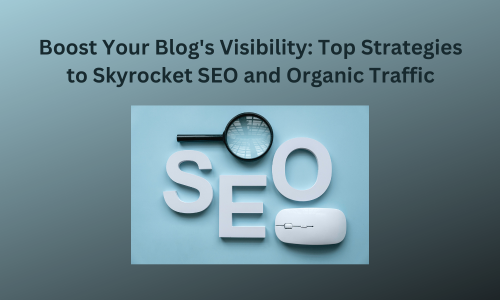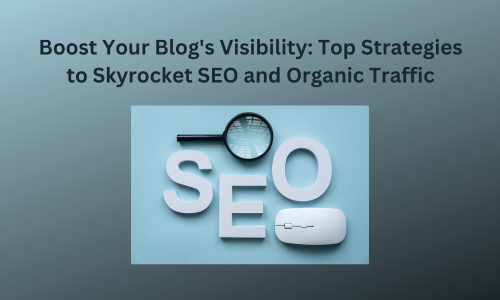


In today's digital landscape, having a blog isn't enough—you need to ensure it's easily found by your target audience. This is where Search Engine Optimization (SEO) comes in. Effective SEO can elevate your blog's visibility in search engines, driving more organic traffic and ultimately, more success. But how do you achieve this? Let’s dive into comprehensive, actionable tips to help you climb the search engine ranks and increase organic traffic.
To rank well, you need to target the right keywords. Start by identifying keywords that your audience is searching for, using tools like Google Keyword Planner, Ahrefs, or SEMrush. Look for keywords with a good balance of search volume and low competition. Incorporating these into your content will help your blog appear in relevant search results.
On-page SEO refers to optimizing individual pages on your blog. Focus on your title tags, meta descriptions, headers, and the content itself. Each should include your primary keywords naturally and compellingly. Don’t forget about mobile optimization—Google now prioritizes mobile-first indexing, so ensure your blog is mobile-friendly to avoid losing ranking points.
Content is king in the world of SEO. Your blog posts should provide value, answer questions, and engage readers. Focus on creating in-depth, informative content that meets the search intent of your audience. When your content is useful, readers will spend more time on your site, signalling to search engines that your blog is worth ranking higher.
Longer content tends to perform better in search engines, but only if it’s well-organized and easy to read. Break up your posts with H2 and H3 headers, bullet points, and short paragraphs. This not only improves readability but also makes it easier for search engines to understand and index your content.
Incorporating images, infographics, and videos can significantly enhance user experience and keep readers engaged. However, don't overlook the importance of SEO for these elements. Optimize images with descriptive Alt text that includes relevant keywords. This not only helps with SEO but also makes your content more accessible.
Internal links connect your blog posts, helping readers discover more of your content. External links to authoritative sites can boost your blog’s credibility. Both strategies are key for improving SEO. Internal links improve site navigation and reduce bounce rates, while external links signal to search engines that your content is well-researched and trustworthy.
A slow-loading site can hurt both user experience and SEO rankings. Use tools like Google PageSpeed Insights to assess and improve your site’s speed. Compress images, use browser caching, and consider a content delivery network (CDN) to ensure your blog loads quickly.
Your URLs should be clean, descriptive, and easy to read. A simple, keyword-rich URL structure not only makes it easier for users to understand what your content is about, but also improves search engine indexing.
An XML sitemap helps search engines find and index all the pages on your site, while a well-configured robots.txt file ensures that search engines focus on the content you want to be indexed. Regularly update and submit your sitemap to Google Search Console for optimal indexing.
User engagement metrics like bounce rate (the percentage of visitors who leave your site after viewing one page) and dwell time (how long a visitor stays on a page) are crucial for SEO. To improve these metrics, create compelling, easy-to-read content that keeps readers on your page longer. Use related posts widgets and calls to action (CTAs) to encourage further exploration.
A well-structured post with short paragraphs, bullet points, and clear language is easier to read and more likely to keep visitors engaged. Tools like Hemingway App can help you simplify complex sentences and improve the overall readability of your content.
Guest blogging on reputable sites within your niche is a powerful way to build backlinks to your blog. Backlinks from high-authority sites signal to search engines that your content is credible, which can significantly improve your rankings.
Building relationships with other bloggers, influencers, and industry leaders can lead to natural backlink opportunities. Engage with them on social media, comment on their posts, and share their content. Networking can open doors for collaborations, mentions, and backlinks.
Promoting your content on social media, in forums, and through email outreach can help attract natural backlinks. The more visible your content is, the higher the chance that others will link to it, enhancing your blog’s authority and search engine rankings.
For local businesses, having a well-optimized Google My Business profile is crucial. Ensure your business name, address, and phone number (NAP) are consistent across your website and all online directories. Encourage satisfied customers to leave positive reviews, as these can boost your local SEO.
If your blog targets a local audience, incorporate local keywords into your content. For instance, a bakery in New York might use keywords like “best bakery in New York City” or “NYC cupcakes.” Localized content can help your blog rank higher for searches in your specific area.
Google Analytics is an essential tool for tracking your blog’s performance. It allows you to monitor traffic, user behaviour, conversion rates, and more. Regularly reviewing these metrics can help you understand what’s working and where there’s room for improvement.
Google Search Console provides insights into your blog’s search performance, including search queries that bring traffic, click-through rates, and any indexing issues. Use this tool to identify and fix problems that could be hindering your SEO efforts.
Regularly audit your blog to ensure it remains optimized. Check for broken links, outdated content, and technical issues that could impact your SEO. An audit helps you stay proactive and keep your blog in line with the latest SEO best practices.
Google frequently updates its search algorithms, which can impact your blog’s rankings. Staying informed about these changes and adjusting your strategy accordingly is essential to maintaining and improving your SEO performance.
SEO is an ever-evolving field. Follow SEO blogs, attend webinars, and take courses to stay current with best practices. Continuous learning will help you stay ahead of the competition and adapt to changes in the SEO landscape.
If you’re using WordPress, plugins like Yoast SEO or Rank Math can simplify the process of optimizing your content. These tools offer real-time suggestions and can automate many on-page SEO tasks.
A content calendar helps you plan and organize your blog posts strategically. By consistently publishing new content, you can cover a variety of topics, target different keywords, and keep your blog fresh and engaging for readers.
Study your competitors’ blogs to see what’s working for them. Analyse their content, keywords, and backlink profiles to identify gaps and opportunities. This can inspire new ideas and help you stay competitive in your niche.
Improving your blog’s SEO and driving more organic traffic is a continuous process that requires time, effort, and dedication. By following these strategies—conducting thorough keyword research, optimizing your content, building quality backlinks, and staying informed about SEO trends—you can significantly boost your blog’s visibility in search engines. Start implementing these tips today, and watch your blog rise to the top of the search results.
Remember, SEO is a marathon, not a sprint. Stay patient, stay consistent, and success will follow.
Disclaimer: This article is provided for informational purposes only. It is not offered or intended to be used as legal, tax, investment, financial, or other advice.
